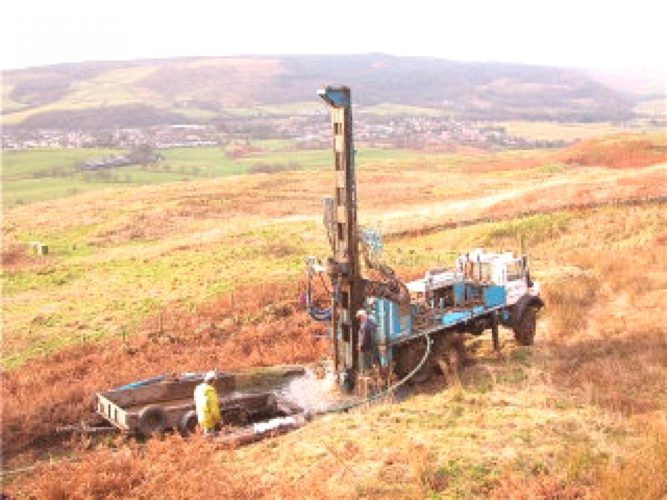Most smallholders and small farmers ~ unless they are lucky enough to have a permanent unpolluted river or stream bordering or running though their property ~ will receive their water from a borehole somewhere on their land. The use of a borehole is also one of the most common uses for pumps on a smallholding.
Indeed, if a borehole is to be the source of water for the property, the assuredness of a good, constant yield, and the quality and care taken to drill and equip the hole, should be among the key determining factors when deciding to buy the land in the first place.
For a borehole is not simply a deep, round hole in the ground down which one puts a pump. It’s a complex combination of science and engineering that, done correctly, will do its job unfailingly for decades but which if done shoddily will cause the landowner endless grief.
Finding your water source
Key to a good hole and decent yield, of course, is to find a decent source of water underground, usually either a dolomitic chamber filled with ancient unpolluted water, or a nicely flowing aquifer.
Dolomitic chambers can bring with them their own set of problems, not the least of which is the threat of sinkholes.
More commonly, one will be seeking the elusive subterranean aquifer, in reality no more than a fissure in the underground rock which allows water to flow or seep through. Finding a decent aquifer requires the services of either some sophisticated scientific devices which, if used properly and interpreted correctly, can give an indication of the location of the aquifer, direction of flow, depth and possibly even an indication of yield. But to exploit this information, the hole must be sited with pinpoint precision because the aquifer may not be more than a few centimetres wide.
Of course, many good holes have been found not by using advanced sleuthing and scientific instruments, but by people gifted with the ability to “divine” water sources. These individuals use a variety of methods and material to detect water, such as forked sticks, or pieces of wire. Legend has it that there was once a granny with divining skills. Her method was different, however. She would put herself into a trance-like state and wander around the property. Where she squatted and urinated on the ground one was, she was adamant, going to find water. Her success rate is not known.
Depth of borehole
The depth of the aquifer will, of course, determine the depth of the hole and it is a sad fact that South Africa’s underground water table (the level at which subterranean water is located) is dropping. Thus, new boreholes generally need to be deeper to reach decent water than those drilled decades ago. This is especially true in smallholding areas where property subdivisions are seeing increasing numbers of dwellings and residents.
The deeper the hole, generally, the greater its cost, and the greater the cost of equipping it. And equipping it does not only mean the cost of the pump, cable and pipe. A borehole needs to be lined to prevent it from collapsing in on itself over time.
And here’s one of the biggest causes of borehole failure: Negligence or cost-cutting on the part of the borehole driller who may choose to scrimp or cut corners on installing the lining. For only years later will the hapless plot owner suffer the consequences.
The first consequence will be that the borehole suddenly starts to yield less, and the water yielded will be dirty. Next, the pump will stop entirely, having become clogged with mud and debris. Finally, attempts to lift the pump out of the hole, either to clean or replace it, will result in it jamming in the hole.
At this stage a specialist borehole servicing company will be required, bringing with it the necessary equipment to clear the stuck pump, reline the hole and clear the debris from the bottom.
This last stage is done by pumping a gluey compound down the hole and allowing it to mix with the loose material at the bottom of the hole. This glutinous, frothy mass is then blasted out of the hole under high pressure.
This is the final in a five-part series on Pumps. For the rest of the series, click here.


Thanks, for the info!
Apparently one of the most imported issues are not mentioned!
The water, aquifer, the water detecting person’s are all standing in question. But one of the biggest problems is with the “BOREHOLE DRILLER, EQUIPMENT AND WORKING METHODS”
The borehole drillers are out to make their money, the more meters the better money!! The Quicker the drilling the more holes and money can be made !! And only the land owner are caring the cost!!
I have 3 hole drilled, 2 holes 150mm by one company one hole 16m skew! Depth 70m Other hole 46m skew!! 150m
Other contractor drill a hole 200mm hole 130m depth 32m skew!!
This skew holes sit the number 1 reason people lost “thousands and thousands of Rands” without getting the expected water!!!
I have the holes tested and have the proof and electronic printouts!!
Now you can try to get money back or the hole re- drilled but, the contractors just give you a bad name an runaway!!
I do have the names of the contractors and the specialist borehole surveys available if you are interested!!
PLEASE WARN THE PEOPLE !!
“ klein karoo”